Choosing a small corner bath

Small corner baths are ideal for rooms with limited space. They allow the most practical use of every centimeter of space, while they will look good in all style solutions. In this material, you will get acquainted with the features of choosing small corner baths.

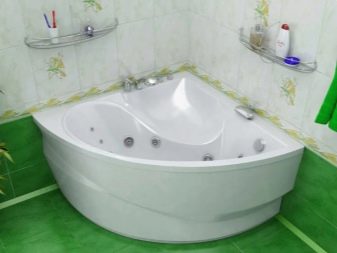
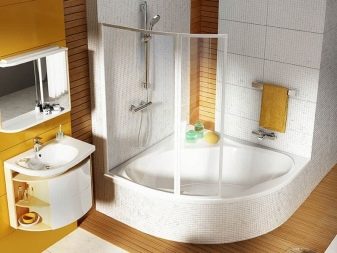

Advantages and disadvantages
Modern corner baths have a huge number of pluses in comparison with the classic rectangular and square options.
- Corner bathroom - ideal for installation in a small room... It allows you to effectively distribute and plan every free centimeter of the room and successfully place all the planned furniture and plumbing in the room.

- Corner types of baths are considered the safest, since for the most part they have a rounded shape, where there are no sharp corners that children or the elderly can hit.



- Despite the angular arrangement of such baths, they can be made in different shapes and from different materials, as well as in a wide variety of designs and colors. In this regard, they are in no way inferior to the classic versions of fonts.
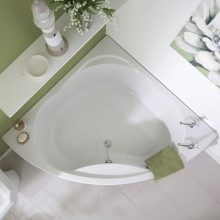

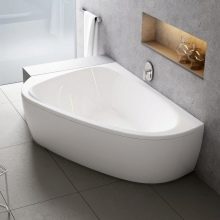
- Small dimensions and external laconicism do not overload the interior of the bathroom, make it lighter, more direct and aesthetic. In addition, such bathtubs can successfully complement a particular style or dilute a particular style solution.


- Like classic hot tub models, corner options may include additional functions, which will make the use of this type of plumbing even more pleasant and comfortable.


- Despite the common myth, corner baths have almost the same displacement as the classic models.

The only drawback of corner fonts is that they will not be able to fully stretch their legs, especially for tall people. The rest of the disadvantages of such bathtubs will relate to a specific material or to a particular model.

Materials (edit)
Most often, in the manufacture of bathroom fixtures, 5 materials are used: cast iron, metal (in the form of aluminum, steel or stainless steel), minerals, acrylic, as well as its more modern version - kvaril.
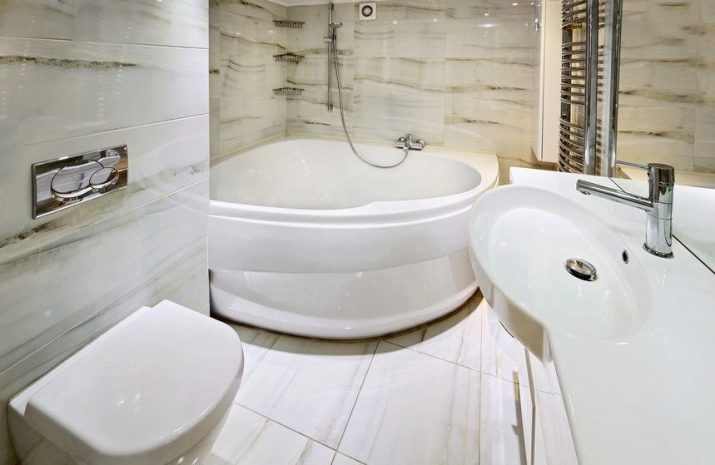
The pros and cons of each of these materials will be discussed below when creating small corner fonts.
- Cast iron. This material is not used very often in the creation of corner baths, since it does not have sufficient plasticity and is difficult to process. Despite this, cast iron baths are considered the most durable, reliable and quiet. However, this material also has its drawbacks - first of all, a large weight, which is why such products need a sturdier installation, as well as a high cost for high-quality cast iron models. Cast iron products are usually covered with a thick layer of enamel, which can become thinner over time.
Cast iron models will look best in bathrooms styled in retro or country style.

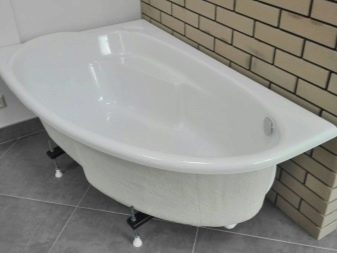
- Steel. It is much easier to find stainless steel hot tubs on the market - these bathtubs can be made in any size and shape, in addition, steel is much lighter than cast iron, is not particularly picky about care and does not need reliable fastening.
There are also disadvantages: steel products make a lot of noise under the streams of water, cool quickly, although they quickly heat up, and can also deform from temperature extremes. Steel fonts are also covered with a layer of enamel, but in their case it is thinner than that of cast iron units.
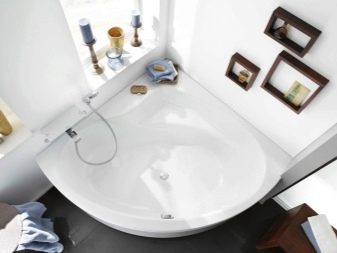

- Acrylic. Today it is the most popular material for making hot tubs. It is strong enough, can take any shape and does not particularly make noise from the impact of a jet of water. Products made of cast acrylic are more durable. Despite its good strength, acrylic does not tolerate mechanical damage - scratches, cracks and dents will be noticeable on this material.


- Kvaril. This material is a mixture of quartz and acrylic. It has a stronger and more durable structure than acrylic, and has a characteristic glossy sheen that sets it apart from all other materials. As with acrylic, quartz fonts can take any shape, but they usually cost a lot more than acrylic options.

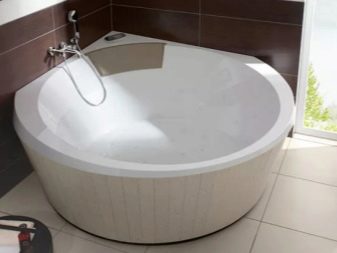
- Minerals. This group includes corner models made of artificial or natural stone. Most often it is artificial marble. Despite the excellent strength characteristics and resistance to abrasive agents, these products attract more attention precisely for their appearance.
Due to their luxurious appearance and high price, such products are exclusively installed in richly furnished modern or classic bathrooms.

Equipment and functionality
Modern corner baths are equipped with the widest range of additional functions designed to make the process of using the hot tub even more pleasant and comfortable.

Among them are:
- remote control;
- built-in hydro and air massage;
- automatic and manual adjustment of the water supply power;
- additional armrests or soft headboards;
- seats for a comfortable shower;
- safety handles and towel dryers;
- shelves for installing bathroom accessories;
- water temperature control sensors;
- backlight and chromotherapy function (light therapy);
- electronic screen for control of functions and power settings;
- water disinfection system;
- non-slip bottom surface;
- dry run protection systems and overflow grilles.
In addition, corner baths should be equipped with support legs or hooks for fixing the unit directly to the wall.


Shapes and sizes
In stores, you can find symmetrical and asymmetrical versions of bathtubs, as well as models of non-standard shapes.
- Symmetrical. Such units are completely universal, as they can look good in any corner, while being firmly attached to the walls of the bathroom. In symmetrical fonts, mixers and taps are located on the side walls or, in rare cases, on the front of the font. A common variant of symmetrical units can also be considered a hexagonal font, which at the same time takes up little space and is spacious enough for taking a bath.

- Asymmetrical. This group includes trapezoidal models of bathtubs and fonts in the form of a truncated oval. Such models are subdivided into right-handed and left-handed. Their main advantage is that they allow you to stretch your legs and can be used to install shower curtains.


- Non-standard forms... Usually these are expensive models of corner baths that are installed to maintain a certain style in the room. Moreover, these fonts are usually made to order according to the special preferences of the client. Of the non-standard shapes that are most often found on the market, petal options and trimmed tear-shaped models can be distinguished.

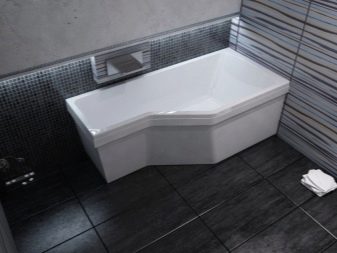
As for the dimensions, all models of corner baths with dimensions less than 140x140 cm (in the case of symmetrical ones) and 75x150 (for asymmetric ones) are already considered small. If we talk about small corner models, then the most popular sizes are considered options 120x120 cm, as well as 130x130 cm.The capacity of the font itself in this case can range from 200 to 300 liters.
In stores, you can find corner fonts in very small sizes - for example, 120x80 or 100x70 cm, but such models are bought exclusively in small bathrooms with a limited amount of free space.


How to choose?
There are several important factors to consider when choosing small corner baths.
- Equipment. First of all, you need to evaluate the complexion or size of all family members who will use the corner bath. Keep in mind that overweight people will find it difficult to use this version of the font, especially when it comes to an asymmetric model.

- Security. If your family has children or elderly people, exclude from the selection of the model of corner bathrooms with sharp corners - fortunately, there are very few such products on the market.

- Dimensions. Before going to the store, you need to take accurate measurements of the bathroom and the area in the room where the font will be located. It is very important to pay attention to the width of the passage in the bathroom, as well as the location of the rest of the furniture and plumbing. In order to protect yourself as much as possible in this regard, draw up a floor plan in advance, taking into account the size of all furniture.
Do not forget to leave a few free, safety centimeters to place the bath next to the already installed furniture.

- Functional. Decide exactly why you need a hot tub. If this unit is designed exclusively for washing or washing clothes, it will be more profitable to stay with standard models without additional functions. Buyers looking to get the most out of such plumbing may want to consider options with built-in features like lights or hydromassage.

- Manufacturing material. This is a very important factor that you should decide on before going to the store. Remember that the most expensive items are cast iron, quartz and artificial stone, the cheapest are steel. Cast-iron baths will be the most reliable in this case, but steel and acrylic ones are unlikely to last longer than 15 years. Also pay attention to the weight of the model - cast iron will be the heaviest, and therefore, before buying them, you need to plan the installation conditions in advance and prepare additional fasteners.

- Design... Choose a bath model based on the interior and style of your bathroom.The hot tub should be in harmony with the color scheme of your room, emphasize or complement certain details or interior elements.

- Curtains... If in the future you plan to install curtains for the bathroom, you should select models with curtains and a rod of the same shape. Otherwise, you will have to spend a lot of time looking for a suitable option in the future.

- Purchase and appearance. When choosing small corner fonts, it is better to focus on the range of official websites of large manufacturers, this will protect you from buying a fake. When choosing a bath in a store, pay attention to the appearance of the model. Make sure the surface of the product is free from scratches, chips, bends, dents or cracks.
Do not forget to draw up warranty documents and familiarize yourself with the quality certificate for the equipment.
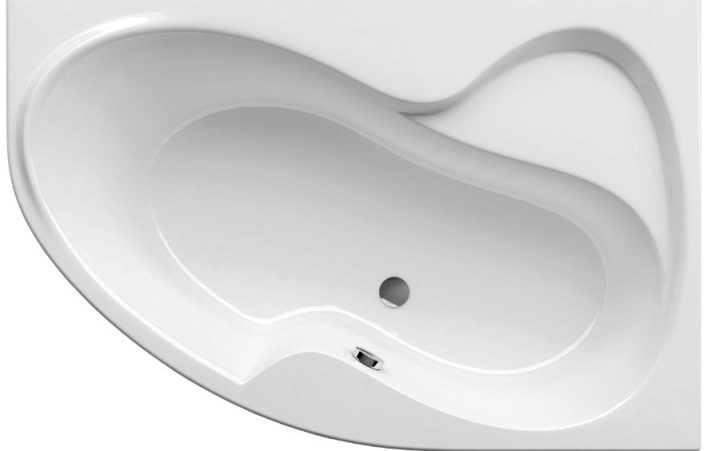
In the next video, you will learn how to choose the right corner bath for a small bathroom.








